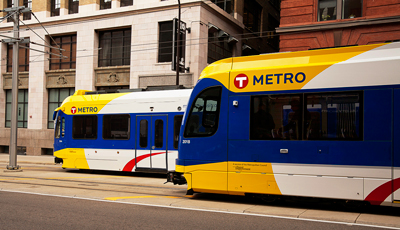Metro Transit's fleet of buses and trains keeps the Twin Cities moving
Bus
 At the end of 2018, Metro Transit had more than 900 buses in its fleet. The majority of buses in Metro Transit's fleet are 40-feet standard diesel buses. Articulated, 60-foot buses are typically used on express routes that operate only during the busiest times of day (rush hours) and make fewer stops. Coach buses are used for express service.
At the end of 2018, Metro Transit had more than 900 buses in its fleet. The majority of buses in Metro Transit's fleet are 40-feet standard diesel buses. Articulated, 60-foot buses are typically used on express routes that operate only during the busiest times of day (rush hours) and make fewer stops. Coach buses are used for express service.
Hybrid buses were introduced in 2002 and now comprise approximately 15% of the fleet. Hybrid buses are propelled partially by electric power stored in a large battery on the roof of buses. These buses have at least 25% better fuel economy than standard buses, operate very quietly and recharge the battery when braking. In 2012, Metro Transit put two super-hybrid buses into service. The buses utilize all-electric components to reduce emissions. Fleet-wide fuel efficiency has improved 15% since 2008 due to the addition of hybrid buses and improved performance on diesel buses. In 2019, Metro Transit launched eight fully electric buses – with no tailpipe emissions – on the METRO C Line, the first transit system in the region to do so.
Buses are stored and maintained at five service garages and the Overhaul Base in St. Paul. Based on regional and federal guidelines, the regular service life of a transit bus is 12 years. Advances in technology and a continued focus on maintenance has made Metro Transit's fleet more reliable than ever. In 2018, buses traveled an average of 7,552 miles between maintenance road call. Metro Transit's buses are typically used for a year or two to provide service to the Minnesota State Fair and have more than 400,000 miles on their odometers by the time they are sold through public auction.
Metro Transit continually evaluates route capacity, level of service and schedule performance to determine which vehicles are most effective on which routes. These considerations are also considered when making new bus purchases.
> Good Question: Why use a 40- or 60-foot bus?
> Old buses get new life
Light Rail
 There are two types of light-rail vehicles in operation on the METRO Blue Line and METRO Green Line. Bombardier light-rail vehicles were put into service when the METRO Blue Line opened in 2004. Siemens S70 light-rail vehicles were added to the fleet when the METRO Green Line opened in June 2014.
There are two types of light-rail vehicles in operation on the METRO Blue Line and METRO Green Line. Bombardier light-rail vehicles were put into service when the METRO Blue Line opened in 2004. Siemens S70 light-rail vehicles were added to the fleet when the METRO Green Line opened in June 2014.
At the end of 2018, Metro Transit had 27 Bombardier and 64 Siemens light-rail vehicles. Both models can operate on either line. Light-rail vehicles run on energy transferred from overhead power lines, which means they produce no emissions.
Light-rail vehicles are stored at operations and maintenance facilities in south Minneapolis and Lowertown St. Paul.
> Pioneer Press: How the Green Line trains work
> Light rail vehicles ready for all seasons
Northstar
The Northstar Commuter Rail Line fleet includes six locomotives and 18 passenger rail cars. Each rail car can carry up to 145 seated customers.